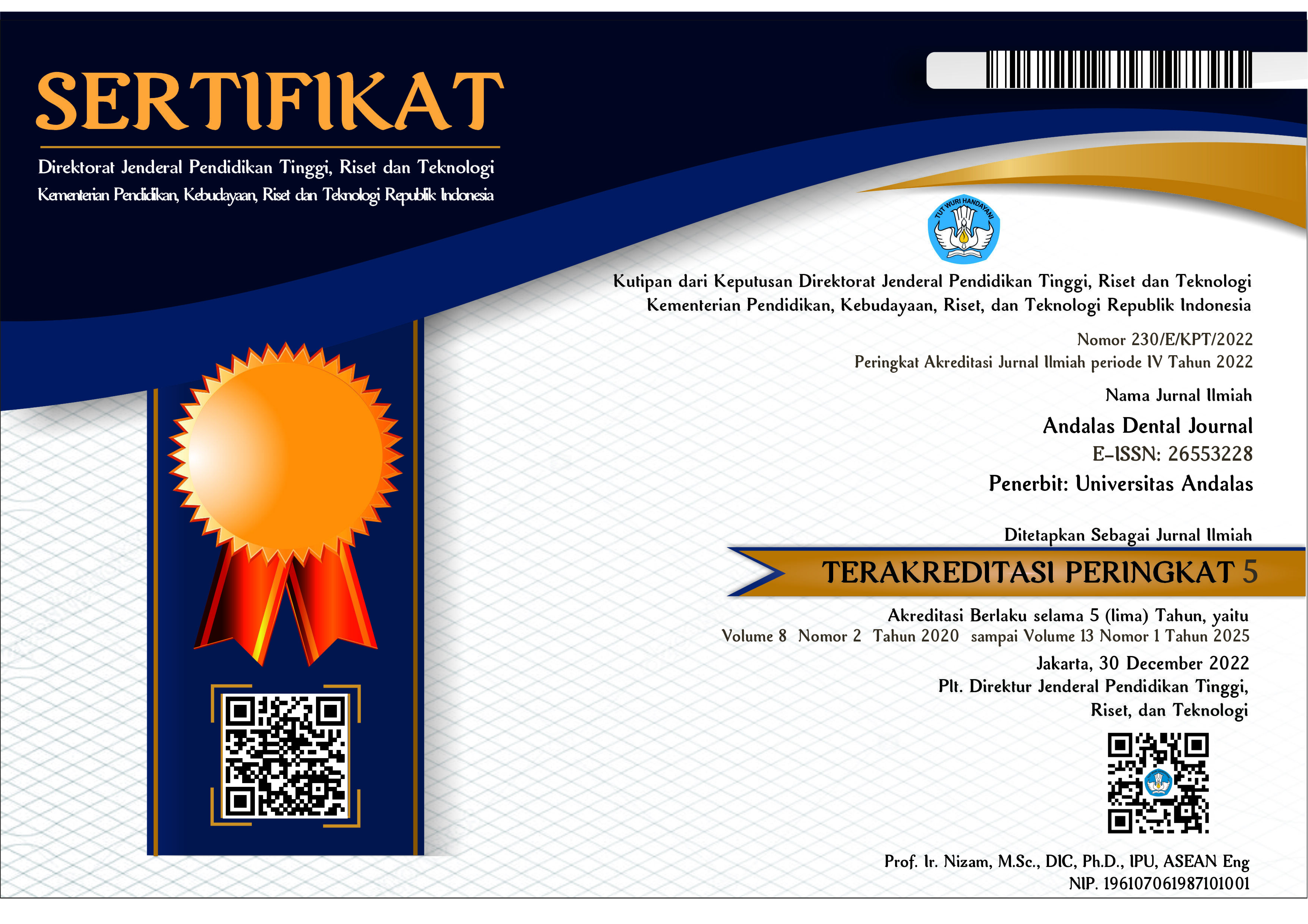Hubungan Riwayat Pola Mengonsumsi Susu Botol dengan Tingkat Keparahan Early Childhood Caries (ECC) pada Anak Usia 3-5 tahun di Kecamatan Kuranji Kota Padang
Abstract
Early Childhood Caries (ECC) is a state of occurrence of decayed (cavities and non cavities), missing (due to caries), or filling on one or more deciduous teeth in children aged ≤ 71 months. Wayne (1999) divided the severity of ECC into three classifications based on clinical signs, causes, and age of the child namely type I (mild), type II (moderate), and type III (severe). The rate of caries incidence is increasing in children who consume milk using bottles. Clinical pattern to ECC caused by bottle feeding has a distinctive pattern, which is about four upper incisors, while four lower incisors usually remain healthy. This study aims to determine the correlation between the history and pattern of bottle feeding and the severity of ECC in children aged 3-5 years in Kuranji District, Padang City. This study is an analytical study with a cross sectional approach. The study sample consisted of 58 children aged 3-5 years with a history of bottle feeding for at least two years. Samples are selected through consecutive sampling technique. Data are collected using questionnaires and through examining respondents' oral cavity. Data collected are analyzed using Chi-Square Test. Statistical test result shown p < 0,15 for each pattern of bottle feeding duration in years, the time of bottle feeding, the addition of sweeteners, and preventive measures. P is valued as > 0,15 for bottle feeding method. There is a significant relationship between the history and the pattern of bottle feeding duration in years, the time of bottle feeding, the addition of sweeteners, and preventive measures with the severity of ECC in children aged 3-5 years in Kuranji District, Padang City.
References
2. Kahar P, Harvey IS, Tisone CA, Khanna D. Prevalence of Dental Caries, Patterns of Oral Hygiene Behaviors, and Daily Habits in Rural Central India: A Cross Sectional Study. Journal of Indian Association of Public Health Dentistry. 2016; 14(4): 389-396.
3. GBD. Disease and Injury Incidence and Prevalence Collaborators. (2016). Global, regional, and national incidence, prevalence, and years lived with disability for 310 diseases and injuries, 1990–2015: a systematic analysis for the Global Burden of Disease Study 2015. Lancet. 2016; 388:1545–1602.
4. Colak H, Dulgergil CT, Dalli M, Hamidi MM. Early childhood caries update: A review of causes, diagnoses, and treatments. Journal of Natural Science, Biology and Medicine. 2013; 4(1):29−38.
5. Kementerian Kesehatan Republik Indonesia. Riset Kesehatan Dasar (Riskesdas 2013). Jakarta; 2013.
6. Adhani R, Sari NN, Aspriyanto D. Nursing mouth caries anak 2-5 tahun di Puskesmas Cempaka Banjarmasin. Jurnal PDGI. 2014; 63(1):1-7.
7. Damle SG, et al. Transmission Of Mutans Streptococci in Mother-Child Pairs. Indian Journal of Medical Research. 2016; 144(2): 264-270.
8. Kunin AA, Evdokimova AY, Moiseeva NS. Age-related differences of tooth enamel morphochemistry in health and dental caries. The EPMA Journal. 2015; 6: 3.
9. Meyer F, Enax J. Early Childhood Caries: Epidemiology, Aetiology, and Prevention. International Journal of Dentistry. 2018; 2018(1415873): 1-7.
10. Chou R, Cantor A, Zakher B, Mitchell JP, Pappas M. Preventing Dental Caries in Children 5 Years: Systematic Review Updating USPSTF Recommendation. PEDIATRICS. 2013; 132(2): 332–350.
11. Martins LG, Pereira, KC, Costa SX, Traebert E, Lunardelli SE, Lunardelli AN, et al. Impact of Dental Caries on Quality of Life of School Children. Brazilian Research in Pediatric Dentistry and Integrated Clinic. 2016; 16(1): 307-312.
12. Nabuab JD, Duijster D, Benzian H, Weltzien RH, Homsavath A, Monse B, et al. Nutritional Status, Dental Caries And Tooth Eruption In Children: A Longitudinal Study In Cambodia, Indonesia and Lao PDR. BMC Pediatrics. 2018; 18: 300.
13. American Academy of Pediatric Dentistry. Policy on Early Childhood Caries (ECC): Classifications, Consequences, and Preventive Strategies Reference Manual. 2016; 40(6): 60-62.
14. Anil S, Anand PS. Early Childhood Caries: Prevalence, Risk Factors, and Prevention. Front. Pediatr., 2017; 5: 157.
15. Ghaitsa, Widodo, Adhani R. Perbandingan Indeks Karies Antara Anak Yang Mengkonsumsi Susu Botol dengan Tanpa Botol Usia 2-5 Tahun. Dentino (Jur.Ked. Gigi). 2017; II(2): 205-210.
16. Alazmah A. Early Childhood Caries: A Review. The Journal of Contemporary Dental Practice. 2017; 18(8): 1-6.
17. Muthu M, Sivakumar N. Paediatric Dentistry: Principles and Practice Ed.1. India: Elsevier; 2009.
18. Winda SU, Gunawan P, Wicaksono DA. Gambaran Karies Rampan Pada Siswa Pendidikan Anak Usia Dini di Desa Pineleng II Indah. Jurnal e-Gigi. 2015; 3(1): 175-181.
19. Münevveroğlu AP, Koruyucu M, Seymen F. Risk Factors for Early Childhood Caries (ECC) in 2-5 Years Old Children. İstanbul Üniversitesi Diş Hekimliği Fakültesi Dergisi, 2014; 48(1): 19-30.
20. McDonald RE, Avery DR, Dean JA. Dentistry for the Child and Adolescent, Eighth Edition. USA: Mosby; 2004.
21. Cameron AC, Widmer RP. Handbook of Pediatric Dentistry Ed.3. China: Elsevier; 2008.
22. Pinkham JR, Casamassimo PS, Fields HW, McTigue DJ, Nowak AJ. Pediatric Dentistry: Infancy Through Adolescence. China: Elsevier; 2005.
23. Banerjee A, Watson T F. Pickard Manual Konservasi Restoratif, Ed.9. Jakarta: EGC; 2017.
24. Herrera MD, Solis CE, Sanchez MM, Loyola AP, Rodelo JJ, Granillo HI, Maupome G. Dental Plaque, Preventive Care, and Tooth Brushing Associated with Dental Caries in Primary Teeth in Schoolchildren Ages 6–9 Years of Leon, Nicaragua. Medical Science Monitor. 2013; 19: 1019-1026.
25. O'Mullane DM, BaezRJ, Jones S, Lennon MA, Petersen PE, Rugg-Gunn AJ, Whitford GM. Fluoride and Oral Health. Community Dental Health. 2016; 33: 69–99.
26. Suratri MA, Jovina TA, Notohartojo IT. Hubungan Kejadian Karies Gigi dengan Konsumsi Air Minum pada Masyarakat di Indonesia. Media Litbangkes. 2018; 28(3): 211-218.
27. Medjedovic E, Medjedovic S, Deljo D, Sukalo A. Impact of Fluoride on Dental Health Quality. Mater Sociomed. 2015; 27(6): 395-398.
28. Ten Cate JM. Contemporary Perspective on the Use of Fluoride Products in Caries Prevention. British Dental Journal. 2013; 214(4): 161-167.
Copyright (c) 2021 Annissa Achmadsyah Gewang, Deli Mona, Arymbi Pujiastuty

This work is licensed under a Creative Commons Attribution-ShareAlike 4.0 International License.















